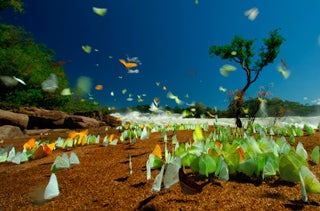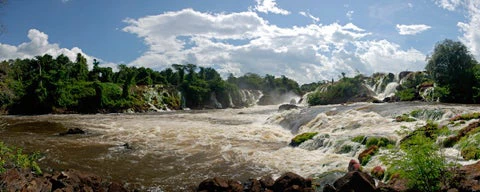También disponible en español
The success of the Amazon Region Protected Areas Program (ARPA) drew a crowd here in Hyderabad at the UN Convention on Biological Diversity meeting. This effort by the government of Brazil – supported by the World Bank, the Global Environment Facility, WWF, and the German Development Bank (KfW) – is protecting almost 60 million hectares of rainforest, an area roughly the size of France and Belgium combined.
Speakers from the governments of Brazil and Germany, as well as from the GEF and foundations, all agreed that ARPA’s results are impressive: Between 2004 and 2006, ARPA accounted for 37 percent of Brazil’s substantial decrease in deforestation, and the program’s first 13 new protected areas will save more than 430 million tons of CO2 emissions through 2050.
An initial investment of $84.5 million and the creation of protected areas, a conservation trust fund to secure long-term financial support, scientific studies, and biodiversity monitoring systems will eventually result in emissions offsets worth $2.2 billion through 2050, assuming $5 a ton for carbon. That’s a 22 percent return on investment.
The program is improving the livelihoods of people in the Amazon region by strengthening the value chains of forest-based products and enabling improved coexistence between small family farms and larger-scale agriculture. Poor families inside the protected areas who adopt environmental conservation actions also benefit through a green conditional cash transfer program, Bolsa Verde, set up by the Brazilian government.
 But speakers today were focused on the need for innovative resource mobilization if we are to continue and expand the ARPA work. Endowment funds, a protected area compensation fund into which companies are required to contribute as a mitigation measure, and new innovative mechanisms bringing together funds from multiple sectors were highlighted. With so much at stake, everyone is searching for innovative ways to leverage private dollars and deliver sustainable funding.
But speakers today were focused on the need for innovative resource mobilization if we are to continue and expand the ARPA work. Endowment funds, a protected area compensation fund into which companies are required to contribute as a mitigation measure, and new innovative mechanisms bringing together funds from multiple sectors were highlighted. With so much at stake, everyone is searching for innovative ways to leverage private dollars and deliver sustainable funding.
Bridging the financing gap for conservation is essential.
Lessons from ARPA
So what are the lessons from this extraordinary program?
First, political leadership and strong partnerships are critical. Brazil’s Ministry of the Environment assumed a strong leadership role, and brought together the nonprofit Brazilian Biodiversity Fund, international donors, civil society, the private sector, state government agencies, and international and domestic technical assistance providers. This alliance-building approach was a game-changer. Previous attempts to significantly increase protected areas had met with only mixed success.
Second, solutions to major challenges require thinking out of the box. ARPA shows us what can be achieved when we get out of our comfort zones and learn how to work together across institutions to build broad support for conservation. Only then will we achieve the kind of successes necessary to safeguard the future of our planet’s wealth of biodiversity.
Finally, the conservation challenges we face cannot be addressed by public sector funding or official development assistance alone. Innovation in bringing private finance to invest in nature’s solutions to sustainable growth is already happening – now it needs to grow to scale.
We’re applying the lessons learned on the ground and spreading the partnership approach to initiatives such as the Global Partnership for Oceans, as well as our natural capital accounting initiative, Wealth Accounting and the Valuation of Ecosystem Services (WAVES). Building partnerships across all sectors is the way to make big things happen.
Rachel Kyte
Vice President for Sustainable Development
www.worldbank.org/sustainabledevelopment
Twitter: @rkyte365
Photos: Tumucumaque National Park and Juruena National Park, both created by ARPA. WWP/Zig Koch



Join the Conversation